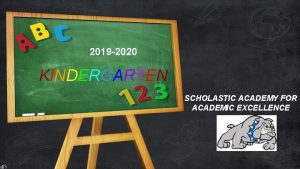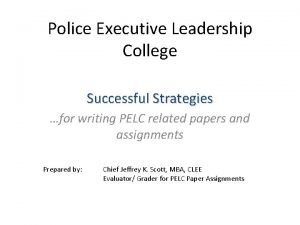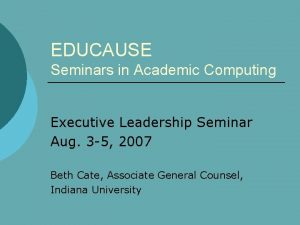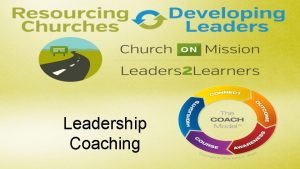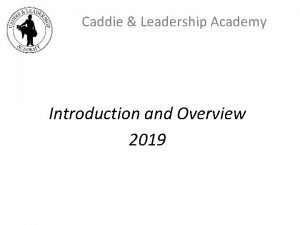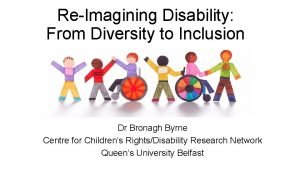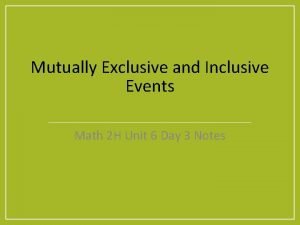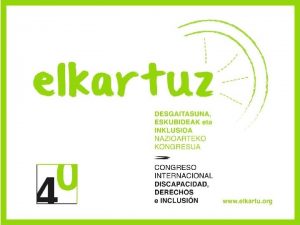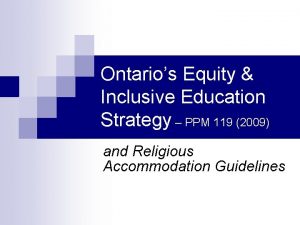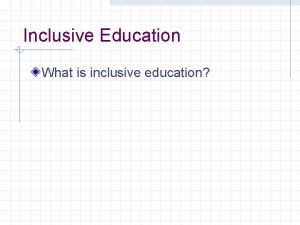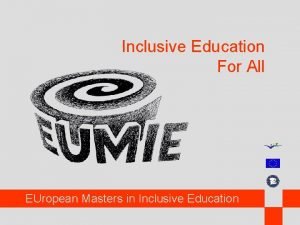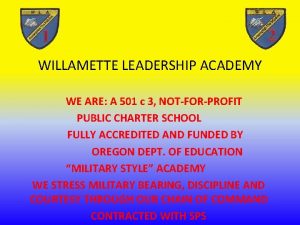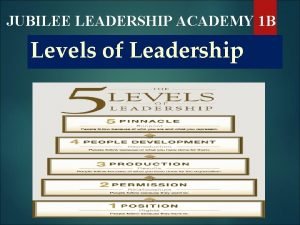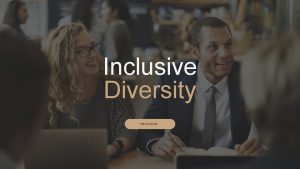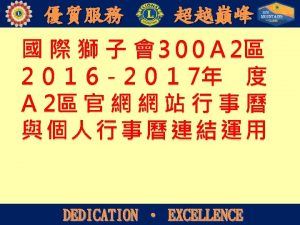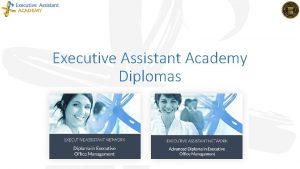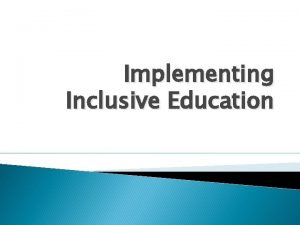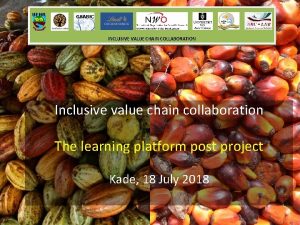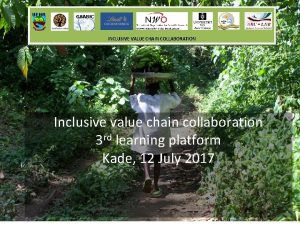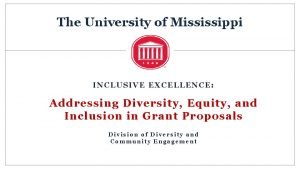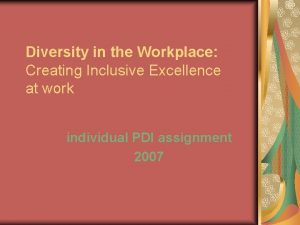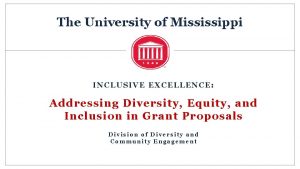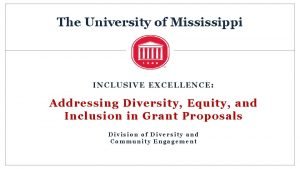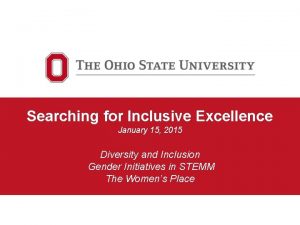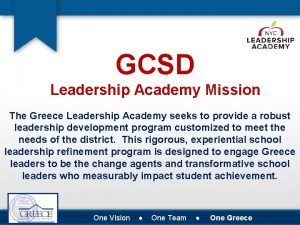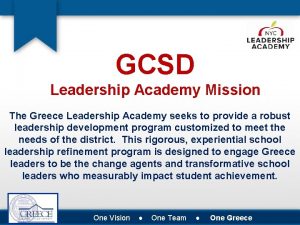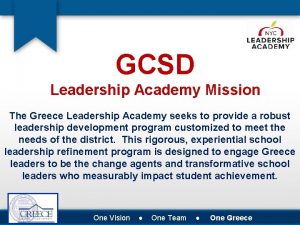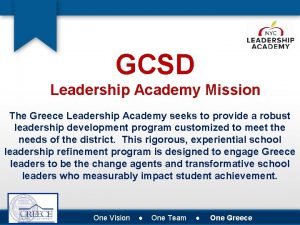Leadership Diversity and Inclusive Excellence Executive Leadership Academy





















- Slides: 21

Leadership, Diversity and Inclusive Excellence Executive Leadership Academy June 9, 2015 Carlos N. Medina, Ed. D. Chief Diversity Officer and Senior Associate Vice Chancellor Office of Diversity, Equity and Inclusion State University of New York

The Importance of Diversity and Inclusive Excellence • Enriches the educational experience • Promotes personal growth—and a healthy society • Strengthens communities and the workplace • Enhances U. S. ’s economic competitiveness

What research says on Diversity • Diversity jolts us into cognitive action in ways that homogeneity simply does not. • People work harder in diverse environments both cognitively and socially. o Hard work can lead to better outcomes. • Creativity and innovation are more likely to spring from diverse rather than from identical groups. • Collective accuracy = average accuracy + diversity o The reason: the diverse groups get stuck less often than the smart individuals, who tended to think similarly. 1. Phillips, Katherine W. (2014). “How Diversity Makes us Smarter. ” Scientific American, 311(4). 2. Dreifus, Claudia. (2008, January 8). A Conversation with Scott E. : In Professor’s Model Diversity = Productivity. The New York Times. http: //www. nytimes. com

A Diversity Framework for Higher Education Climate and Intergroup Relations GLOBAL CONTEXT Education and Scholarship MISSION Access and Success Smith, Daryl G. 2009. Diversity’s Promise for Higher Education. The John Hopkins University Press. LOCAL CONTEXT Institutional Viability And Vitality

Williams & Clowney (2007) Three Models of Organizational Diversity Capabilities in Higher Education

Inclusive Multicultural Compliant Monocultural Metzler, 2001


Strategic Pressures for Change: A Context for Diversity 1. Legal and political dynamics 2. Changing demographics 3. Emergence of a knowledge economy 4. Persistent societal inequities 5. Access alone is not enough

Diversity & Continuous Improvement Implementing Strategies Affecting University Growth Campus Climate Student Success Employment Equity/Faculty and Staff Administrative Leadership

Changing Demographics United States, 2013 New York State, 2013 Native Hawaiian and Other Pacific Islander 0. 2% Native Hawaiian and Other Pacific Islander 0. 1% American Indian and Alaska Native 1. 2% American Indian and Alaska Native 1. 0% Two or More Races 2. 4% Two or More Races 2. 3% Asian Black or African American Hispanic or Latino Asian 5. 3% 13. 2% 17. 1% 8. 2% Black or African American 17. 5% Hispanic or Latino 18. 4% 62. 6% White alone, not Hispanic or Latino 57. 2% Source: U. S. Census Bureau: State and County Quick. Facts. Data derived from Population Estimates, American Community Survey, Census of Population and Housing, State and County Housing Unit Estimates, County Business Patterns, Nonemployer Statistics, Economic Census, Survey of Business Owners, Building Permits

Changing Demographics Demand Greater Focus on Under-Represented Populations Population Increase, Ages 0 -24, (in millions) Percentage Increase, Ages 0 -24, (percentage) Note: Projected Population Growth, Ages 0 -24, 2010 -2050 Source: National Population Projections, U. S. Census Bureau. Released 2008; NCHEMS, Adding It Up, 2007

SUNY’s Student Diversity, 2014

SUNY’s Faculty Diversity, 2014

SUNY Excels ACCESS COMPLETION SUCCESS INQUIRY ENGAGEMENT 1. Full Enrollment Picture 5. Completions 9. SUNY Advantage (Applied Learning, Multi-Cultural Experiences, Student Supports) 11. Total Sponsored Activity 14. START-UP New York and beyond (businesses started / jobs created) 2. NYS Citizens Served by SUNY 6. Student Achievement / Success (SAM) 10. Financial Literacy 12. Course in SIRIS that include handson research, entrepreneurship, etc. 15. Alumni / Philanthropic Support 3. Diversity* 7. Graduation Rates 13. Scholarship, Diversity and Innovation 16. Civic Engagement 4. Capacity – programs and courses 8. Time to Degree 17. Economic Impact *Note that while Diversity is explicitly identified as a metric in Access, working with the Diversity Task Force, SUNY will identify and track inclusive excellence across metrics in all five priority areas.

Diversity Task Force The SUNY Diversity Task Force will guide the development of policies to inform SUNY’s efforts to increase diversity among students, faculty, and staff. Examine all relevant data; review best practices; review existing system-wide initiatives; discuss challenges; and identify strategies that could be supported by policy in four areas: 1. undergraduate and graduate recruitment, admissions, retention and graduation; 2. recruitment, retention, and support of diverse faculty, staff, and administrators; 3. welcoming System/campus environment; and 4. structure and reporting relationships of diversity officers/offices.

The Diversity Officer and Program Standards Diversity Task Force Recommendations 1. Installation of Chief Diversity Officers no later than Fall 2016 2. Senior Leadership “Hires” demonstrate competencies re: diversity 3. Cultural competence training for current members of the senior leadership, faculty and staff – including admissions staff– in all SUNY 4. Development of a Campus Climate Report Card template to capture faculty, staff and student survey data 5. Each campus will address retention plans to foster diverse students across all discipline that demonstrate progress toward SUNY Excel goals and foster programs to address student transitions between programs, colleges and advanced study.

Reframing Diversity for the 21 st Century • Diversity as a core value and not a peripheral one • Building capacity to drive change • Redefining talent, transforming the hiring process • Framing diversity as central to the mission


Diversity Centered Leadership • Acts as a catalyst for demonstrating commitment to diversity • Encourages commitment for diversity/inclusion initiatives • Acts as the primary role model for diversity/inclusion • Provides support for initiatives, policies, programs, practices • Invites, encourage, inspire excellence in diversity/inclusion • Serves as mentor to emerging managers and supervisors • Committed to respecting diverse groups of people • Self aware and assured when it comes to diversity/inclusion • Advocates for diversity and inclusion in all aspects of the organization’s work. Serve as an agent for change

The Attributes of a Diversity President • Definition of Diversity • Diversity Vision • Diversity Commitment • Diversity Knowledge • Curricular Leadership • Organizational Achievements • Diversity Transformation • Diversity Courage

Summary • Diversity exists; our role as leaders is to figure out how to lead the institutional transformation to tie it to our core values. • Diversity requires institutional will and intentionality. • Diversity success requires clearly articulated goals and action plans with benchmarks.
 Diversity
Diversity Scholastic academy for academic excellence
Scholastic academy for academic excellence Genetic diversity and biodiversity
Genetic diversity and biodiversity Ecosystem jigsaw activity
Ecosystem jigsaw activity Trevino and nelson managing business ethics
Trevino and nelson managing business ethics Police executive leadership college
Police executive leadership college Executive leadership seminars
Executive leadership seminars Breakthrough shadow coaching
Breakthrough shadow coaching Caddie and leadership academy
Caddie and leadership academy Ge aviation female diversity recruitment leadership summit
Ge aviation female diversity recruitment leadership summit Reimigining disability and inclusive education
Reimigining disability and inclusive education Inclusive and exclusive math examples
Inclusive and exclusive math examples Reimigining disability and inclusive education
Reimigining disability and inclusive education Ppm 119
Ppm 119 Exclusive
Exclusive Addition rule
Addition rule Inclusive education and community partnership
Inclusive education and community partnership Aims and objectives of inclusive education
Aims and objectives of inclusive education Inclusive education and community partnership
Inclusive education and community partnership Willamette leadership academy middle school
Willamette leadership academy middle school Aacte leadership academy
Aacte leadership academy Jubilee leadership academy
Jubilee leadership academy

